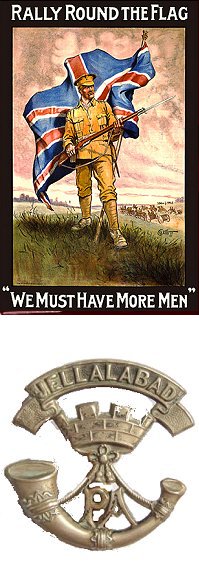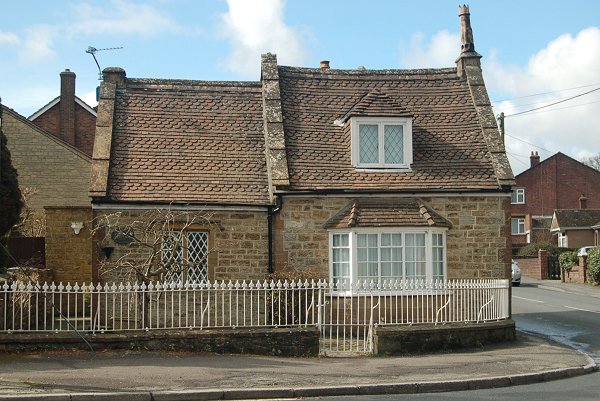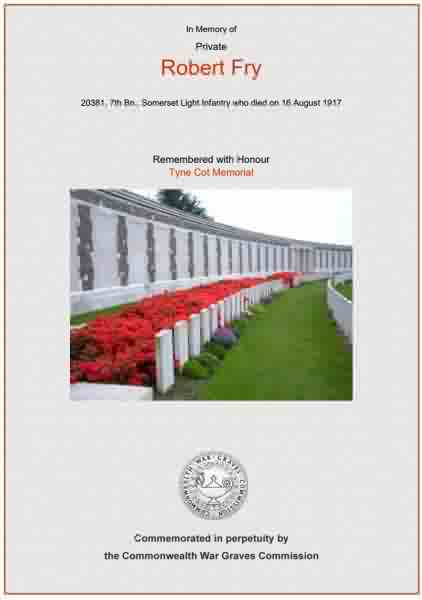yeovil at War
Robert Fry
Killed at the Battle of Langemarck
Robert Fry was born in Yeovil during the autumn of 1895. He was the son of shepherd Herbert Fry (b1866) and Minnie née Burnell (1873-1932) originally of Kingsbury Episcopi. Herbert and Minnie had four children; Edward (b1891, Kingsbury Episcopi), Gertrude (b1894, Yeovil), Robert and an unknown child. In the 1901 census the family were listed living at Turnpike Cottage, Mudford Road. This was originally built on the corner of Combe Street Lane and Mudford Road but was later demolished and rebuilt in its present position on the corner of Mudford Road and St Michael's Avenue. By the time of the 1911 census the family had moved to Larkhill Lane (today's Larkhill Road) which, at this time, was in the parish of Preston Plucknett. Herbert gave his occupation as a shepherd and 15-year old Robert worked as a farm labourer - both of them almost certainly working on Larkhill Farm.
 Robert
Fry enlisted in
the 7th
(Service)
Battalion,
Somerset Light
Infantry. His
Service Number
20381 suggesting
he enlisted
during the
summer of 1916.
Robert
Fry enlisted in
the 7th
(Service)
Battalion,
Somerset Light
Infantry. His
Service Number
20381 suggesting
he enlisted
during the
summer of 1916.
Nothing is known of Robert's military career until, with his battalion, he took part in the Battle of Langemarck.
The Battle of Langemarck from 16 to 18 August 1917, was the second Allied general attack of the Third Battle of Ypres. The Allied attack succeeded in the north, from Langemarck to Drie Grachten ("Three Canals") but early advances in the south on the Gheluvelt Plateau were forced back by powerful German counter-attacks. Both sides were hampered by rain, which had a greater effect on the British who occupied lower-lying areas and advanced onto ground which had been frequently and severely bombarded.
The diary of the 7th Somersets for 15 August reads "Battalion in front line in front of Langemarck, waiting to attack." The Regimental History of the Somerset Light Infantry continues "The night of the15th / 16th of August was spent in making final preparations. The attacking troops had to be in position on the Sitenbeek an hour before Zero, which had been fixed for 4:45am. Of the 7th Somersets, A Company, on the right, and D Company on the left, were to form the first wave. In darkness these two Companies set out to take over the outpost line from the 11th Rifle Brigade. They had to cross the flooded stream, whose banks were boggy and slippery with slimy mud. The garrisons of the posts on the eastern bank had only been able to push forward about 75 yards from the bank and in that limited space the leading Battalions had to form up for the attack. B Company, on the right, and C Company on the left, formed the second wave of the 7th Somerset Light Infantry. Immediately on reaching their allotted positions all companies dug themselves in, and while this work was in progress the enemy frequently sent up Very lights....
At 4:45am the creeping barrage fell with great precision on the enemies shell-a whole posts, and all along the line the advance began.... Men were continually stuck fast in the mud and had to pull each other out, the wild, under a galling machine gun fire from a line of concrete emplacements (pillboxes) near Reitres Farm: here the advance was checked. The check lasted 14 to 15 minutes and during that time casualties were heavy....
At Zero plus 50 minutes (5:35am) B and C Companies left the Blue Line and followed the barrage right through the village.... Heavy machine gun fire, again from concrete buildings at the north-west end of the village, met the advance of these two Companies, who were also worried by hostile snipers from the right flank. Snipers from both Companies, however, were told off to deal with the enemy and, having reduced their activities to nil, B and C organised an attack on the front of the concrete buildings. Both Companies sent forward parties of bombers, under cover of Lewis-gun fire, and very soon the enemies of offensive was broken down, one German officer and 30 men surrendering. The next stronghold was dealt with in a similar manner, bombing parties working forward from shell hole to shell hole, finally bombing the enemy out of his stronghold. 40 more prisoners and four machine guns were captured their this last operation effectively cleared the village and no further opposition was met with."
Sadly Robert Fry was killed during this attack of 16 August 1917. He was aged 22.
Robert is commemorated on Panels 41 to 42 and 163A of the Tyne Cot Memorial and his name is inscribed on the Preston Plucknett War Memorial.
Other Yeovil
lads killed on
this day include
-
Albert Burgess,
Harold Dicks,
Frederick Hunt
and
Alfred Tuck.
gallery

The elevation to St Michael's Avenue of Turnpike Cottage, home to the Fry family at the time of the 1901 census. Photographed in 2013.

The Commonwealth War Graves Commission certificate in memory of Robert Fry.